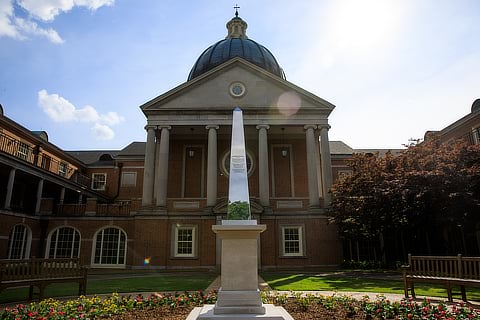

On Tuesday, Feb. 15, Samford University officially dedicated its Racial Reconciliation Memorial during a public worship service on campus. The memorial honors the many contributions of African Americans who built and sustain the institution’s mission while affirming the university’s commitment to reconciliation.
The memorial was authorized by the university’s Board of Trustees and originally installed on May 5, 2020. However, the public dedication was delayed due to restrictions caused by COVID-19.
Shaped in the form of an ancient obelisk, the 8-foot-tall memorial is crafted from stainless steel and stands atop a granite base in the circular garden at Divinity Hall on the west side of the university quadrangle. Consistent with Samford’s core values of integrity, honor, justice, accountability and service to God and the community, the etchings on the monument express the virtues of justice and righteousness and recall the wrongs of slavery and the sins of the resulting violence and racism.
The memorial specifically honors the memory of Harry (1831-1854), a 23-year-old Black man who lived in slavery and died from injuries he received while waking the students at the burning of Howard College. Harry is known in Samford’s history for his bravery that saved lives and sustained the institution. Students from the college first memorialized Harry by placing a monument at his grave in Marion, Alabama, in 1857. He has since been memorialized along the university’s Centennial Walk and a likeness of a young African American man representing Harry is engraved in the university’s ceremonial mace. More than 20 years ago, the Samford Student Government Association approved the naming of the food court coffee house venue in the Ralph Beeson University Center in Harry’s memory. As the 2019 renovation of the university center was underway, several students and university leaders voiced a desire for Samford to find a more visible way to commemorate Harry’s memory and to recognize the many contributions of African Americans throughout Samford’s history. In February 2019, the year marking the 400th anniversary of the landing of the first slaves in this country, the Board of Trustees approved the placement of the memorial.
It also honors the memory of Audrey Lattimore Gaston Howard (1940-1989) who, in 1967, became the first African American student admitted to Samford University. In 1970, she received a Juris Doctor from Samford’s Cumberland School of Law and ultimately became the first African American female in the Southeast appointed to the U.S. Attorney’s Office. In recognizing her distinctive role crossing an unjust racial divide that wrongly existed at institutions across the nation, the university also recognizes the ongoing contributions of all African American students and alumni who followed her pioneering path.
The west side of the obelisk is purposely left blank as an inspiration for the Samford community to continue to write its own story.
President Beck A. Taylor said, “This memorial serves many purposes. It’s a mile-marker of sorts; it reminds us of the journey that we’ve been on as a university—a journey that we must reconcile and lament in some ways, but also the fortitude and the progress and the determination that we have to move the university forward and to be a real leader for racial reconciliation in our country.”
Several participants joined together to provide a moving service for the Samford community including President Taylor, University Trustee Robert Holmes Jr., Director of Diversity Enrichment and Relations Cameron Thomas, and Associate Provost for Student Success and Diversity and Inclusion Denise J. Gregory. A reading of the memorial’s inscription was provided via video and read by President Emeritus Andrew Westmoreland. Reverend John L. Cantelow III, M.Div. ’94, D.Min. ’16, senior pastor of Sixth Avenue Baptist Church and a university trustee, offered the sermon, and Reverend John E. King Jr., pastor of Trinity Baptist Church and a university trustee, provided the prayer of dedication. Samford’s student Gospel Choir led the congregation in hymns. The event concluded with the congregation gathering at the memorial and laying roses in silent reflection and contemplation of its purpose.
President Taylor added, “As a Christ-centered university, Samford is, and can be, a leader in our state, in our region and across the country. Today, I am proud of our people as we look to the future to become a better version of Samford moving forward.”
The monument was crafted in the studios of David Harber, a world-renowned sculptor based in Oxfordshire, England. It is a companion piece to the Armillary Sphere mounted outside Reid Chapel, on the east side of the university quadrangle, which was commissioned from Harber to commemorate Samford’s 175th Anniversary in 2016.
